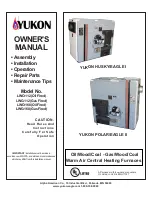
NOTE:
When using an electronic thermostat, set cycle rate for 3
cycles per hr.
CHECK SAFETY CONTROLS
The flame sensor, gas valve, and pressure switch were all checked
in the Start-Up Procedures section as part of normal operation.
1. Check primary limit control.
This control shuts off the combustion control system and
energizes the circulating-air blower motor if the furnace
overheats.
The preferred method of checking the limit control is to
gradually block off the return air after the furnace has been
operating for a period of at least 5 minutes. As soon as the
limit has shut off the burners, the return-air opening should be
unblocked. By using this method to check the limit control, it
can be established that the limit is functioning properly and
operates if there is a motor failure.
2. Check blocked vent safeguard switch.
The purpose of this control is to permit the safe shutdown of
the furnace during certain blocked vent conditions.
a. Disconnect power to furnace and remove vent connector
from furnace outlet collar. Be sure to allow time for vent
pipe to cool down before removing.
b. Restore power to furnace and set room thermostat above
room temperature.
c. After normal start-up, allow furnace to operate for 2
minutes, then block flue outlet 100 percent. Furnace should
cycle off within 2 minutes.
d. Remove blockage and reconnect vent pipe to furnace outlet
collar.
e. Wait 5 minutes and then reset blocked vent safeguard
switch.
3. Check pressure switch.
This control proves operation of draft inducer blower.
a. Turn off 115-v power to furnace.
b. Remove control door and disconnect inducer motor lead
wires from wire harness.
c. Turn on 115-v power to furnace.
d. Set thermostat to "call for heat" and wait 1 minute. When
pressure switch is functioning properly, hot surface igniter
should NOT glow and control diagnostic light flashes a
status code 31. If hot surface igniter glows when inducer
motor is disconnected, shut down furnace immediately.
Determine reason pressure switch did not function properly
and correct condition.
e. Turn off 115-v power to furnace.
f. Reconnect inducer motor wires, replace control door, and
turn on 115-v power to furnace.
4. Check auxiliary limits (when used).
a. Turn off 115-v power to furnace.
b. Remove blower access door.
c. Disconnect red motor lead at blower speed selector. Mark
terminal for proper re-connection.
d. Replace blower access door.
e. Turn on 115-v power to furnace. Be sure room thermostat
is calling for heat.
f. Allow furnace to operate until auxiliary limit activates, but
DO NOT operate furnace longer than 4 minutes.
g. If furnace operates for 4 minutes, check/replace limit
switch(es).
h. Turn off 115-v power to furnace.
i. Remove blower access door.
j. Reconnect red motor lead, reset switch, and replace door.
k. Turn on 115-v power to furnace.
CHECKLIST
1. Put away tools, instruments, and clean up debris.
2. Verify manual reset switches have continuity.
3. Ensure blower and control access doors are properly installed.
4. Cycle test furnace with room thermostat.
5. Check operation of accessories per manufacturer’s instruc-
tions.
6. Review User’s Manual with owner.
7. Leave literature packet near furnace.
Fig. 19—Amp Draw Check With Ammeter
A96316
R
Y W G
10 TURNS
THERMOSTAT SUBBASE
TERMINALS WITH
THERMOSTAT REMOVED
(ANITICIPATOR, CLOCK, ETC.,
MUST BE OUT OF CIRCUIT.)
HOOK-AROUND
AMMETER
EXAMPLE:
5.0 AMPS ON AMMETER
10 TURNS AROUND JAWS
=
0.5 AMPS FOR THERMOSTAT
ANTICIPATOR SETTING
FROM UNIT 24-V
CONTROL TERMINALS
20
→





































